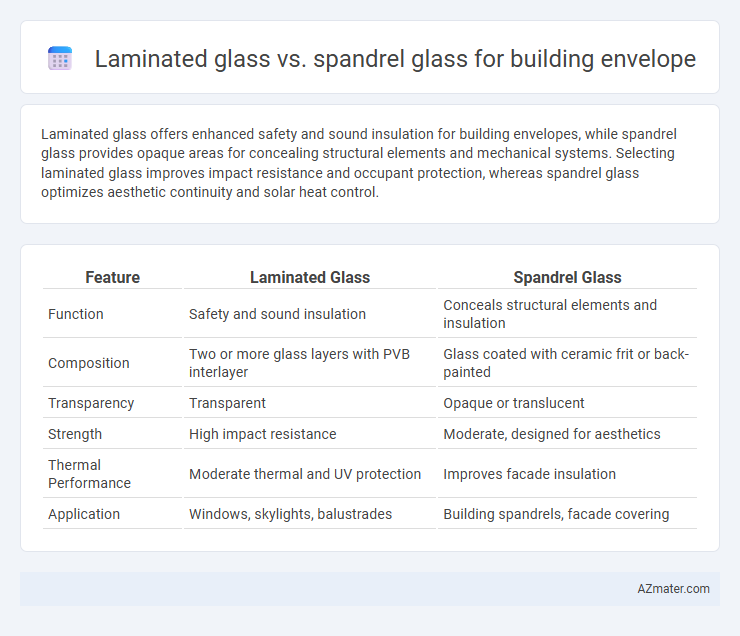Laminated glass offers enhanced safety and sound insulation for building envelopes, while spandrel glass provides opaque areas for concealing structural elements and mechanical systems. Selecting laminated glass improves impact resistance and occupant protection, whereas spandrel glass optimizes aesthetic continuity and solar heat control.
Table of Comparison
| Feature | Laminated Glass | Spandrel Glass |
|---|---|---|
| Function | Safety and sound insulation | Conceals structural elements and insulation |
| Composition | Two or more glass layers with PVB interlayer | Glass coated with ceramic frit or back-painted |
| Transparency | Transparent | Opaque or translucent |
| Strength | High impact resistance | Moderate, designed for aesthetics |
| Thermal Performance | Moderate thermal and UV protection | Improves facade insulation |
| Application | Windows, skylights, balustrades | Building spandrels, facade covering |
Overview of Laminated Glass and Spandrel Glass
Laminated glass consists of two or more glass layers bonded with an interlayer, offering enhanced safety, sound insulation, and UV protection for building envelopes. Spandrel glass is opaque and used to conceal structural elements or mechanical systems, often matching the aesthetic of vision glass while providing thermal insulation and weather resistance. Both types play critical roles in energy efficiency, facade uniformity, and occupant comfort within modern architectural designs.
Key Material Properties and Composition
Laminated glass consists of two or more layers of glass bonded with an interlayer, usually polyvinyl butyral (PVB), providing high impact resistance, enhanced safety, and superior sound insulation, making it ideal for areas requiring security and noise control. Spandrel glass is typically a single glass layer coated or back-painted on the interior side, designed to conceal structural elements within the building envelope while offering lower light transmittance and increased thermal insulation. The key material difference lies in laminated glass's multi-layer composition enhancing mechanical strength and safety, whereas spandrel glass prioritizes aesthetic concealment and energy performance in opaque facade sections.
Aesthetic Differences in Building Envelope Design
Laminated glass offers enhanced clarity and light transmission ideal for transparent facades, while spandrel glass provides opaque, uniform appearance for concealing structural elements in building envelopes. The smooth, reflective surface of spandrel glass enables seamless integration with vision glass, creating a sleek, modern aesthetic that masks mechanical systems or insulation. Laminated glass's ability to incorporate decorative interlayers or frit patterns allows designers to achieve varied visual effects, contributing to dynamic and customizable building exteriors.
Comparative Performance: Transparency vs. Opaqueness
Laminated glass offers superior transparency, allowing natural light to penetrate building envelopes while providing enhanced safety and sound insulation. Spandrel glass is designed for opaqueness, effectively concealing building components such as structural elements and insulation without compromising aesthetic continuity. Choosing between laminated and spandrel glass depends on the desired balance between visibility and concealing building infrastructure in architectural designs.
Energy Efficiency and Thermal Insulation
Laminated glass offers superior thermal insulation in building envelopes by reducing heat transfer through its multiple layers and interlayer materials, enhancing overall energy efficiency. Spandrel glass, typically opaque and used to conceal structural elements, provides effective solar heat gain control and contributes to improved thermal performance by limiting radiant heat infiltration. Choosing laminated glass improves daylight penetration and occupant comfort, while spandrel glass optimizes facade energy performance by managing solar radiation and insulating the building's thermal envelope.
Safety and Security Considerations
Laminated glass offers superior safety by holding shattered pieces together upon impact, reducing injury risk and enhancing security against forced entry in building envelopes. Spandrel glass, typically opaque and used for aesthetic cladding, provides limited impact resistance and is less effective for safety and security compared to laminated glass. Choosing laminated glass ensures compliance with building codes for impact resistance and intruder protection, critical factors in safeguarding occupants and property.
Acoustic Performance and Noise Reduction
Laminated glass provides superior acoustic performance due to its interlayer that dampens sound vibrations, making it highly effective for noise reduction in building envelopes. Spandrel glass, typically opaque and used for aesthetic facade purposes, offers minimal sound insulation as it lacks the sound-dampening interlayer found in laminated glass. For projects prioritizing acoustic comfort and noise control, laminated glass is the optimal choice in the building envelope design.
Cost Factors and Installation Requirements
Laminated glass typically incurs higher costs due to its complex manufacturing process involving multiple glass layers and a PVB interlayer, which also enhances safety and sound insulation for building envelopes. Spandrel glass, used primarily for concealing structural elements and insulation, usually has a lower material cost but requires specialized installation techniques to ensure proper sealing and thermal performance. Installation of laminated glass demands careful handling and precise alignment to maintain its integrity, while spandrel glass installation focuses more on integration with the building's thermal envelope and facade system.
Typical Applications in Modern Architecture
Laminated glass is widely used in building envelopes for safety-critical applications such as facades, balustrades, and skylights due to its impact resistance and ability to hold shards upon breakage. Spandrel glass is commonly applied in opaque building sections like spandrel panels and curtain wall systems to conceal structural elements, insulation, and mechanical components while providing a uniform aesthetic. Both materials contribute to modern architecture by enhancing building performance through durability, energy efficiency, and design flexibility.
Choosing the Right Glass for Your Building Envelope
Choosing the right glass for your building envelope depends on balancing safety, aesthetics, and energy efficiency. Laminated glass offers superior impact resistance and sound insulation, making it ideal for high-traffic areas and safety-critical installations, while spandrel glass conceals structural elements and provides a sleek, uniform facade with excellent thermal performance. Evaluating factors such as building location, design requirements, and energy codes ensures optimal selection between laminated and spandrel glass for enhancing durability and occupant comfort.

Infographic: Laminated glass vs Spandrel glass for Building envelope
 azmater.com
azmater.com